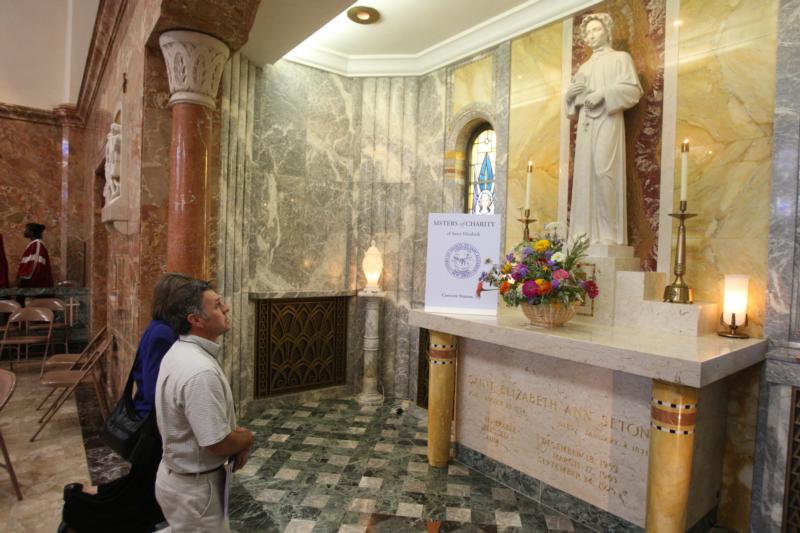
Ivan Pare prays before a statue of St. Elizabeth Ann Seton at the Basilica of the National Shrine of St. Elizabeth Ann Seton in Emmitsburg, Md., after a Mass celebrated Aug. 2, 2009, to mark the 200th anniversary of the foundation of the Sisters of Charity. (CNS photo/Owen Sweeney III, Catholic Review)
Who is your favorite saint?
Oh, what a simple yet very complicated question!
As a child, I learned about saints from mostly secondhand sources and had no clear “favorite” of my own. My first childhood religious book, whose tattered red cover and well-worn pages show just how much I enjoyed it, was laden with illustrations and stories of several saints, including St. Elizabeth, St. Bernadette de Soubirous and St. Joan of Arc — too many amazing examples to choose just one.
My adult relatives and teachers also told stories of the saints, and their enthusiasm was contagious. I enjoyed learning and listening, but skirted overt favoritism because I felt sometimes there was some friction, too, when important decisions such as selecting a confirmation name arose or “St. X School” was going to play “St. Y School” in a hotly contested tournament!
[hotblock]
When I left home for college, I still had no favorite saint. But I wanted to know these holy men and women better, and no better way than to read what they actually wrote.
I began to read St. Thomas Aquinas’ “Summa Theologiae,” St. Augustine of Hippo’s “The Confessions of Saint Augustine,” and “The Passion of St. Perpetua, St. Felicitas, and their Companions” (St. Perpetua’s was the first woman saint’s account of her faith journey and martyrdom), and other original works by the saints.
I learned the historical context of when and how they lived. And I learned more details of their lives, struggles, hopes, faith and how they influenced one another, too (St. Francis of Assisi and St. Clare, for example).
No sound bites, these volumes! It takes more time and effort to read through and understand a book penned by someone who lived centuries ago or was from another culture. But the wisdom and beauty of their words carry faith and God’s grace straight from one heart and soul to another like no abridged version can.
By reading these classic works, I have deepened my personal connection with each saint and found inspiration with these examples of holiness that strengthens with each passing year.
St. Elizabeth Ann Seton’s letters, available online through the Vincentian Heritage Collection, give amazing insight into a woman guided by God but still in deep mourning for profoundly human losses — an inspiration for anyone who is also suffering.
“The Life of Saint Teresa of Avila” by St. Teresa of Avila is a stirring account of her devotion to God, even, at times, in the midst of great physical pain and external challenge.
[hotblock2]
St. Francis de Sales’ “Philotea” (or “An Introduction to the Devout Life”) gives constructive, practical guidance for living in the world, but not of it (and allows glimpses into his sense of humor, too, which helps us get to know him all the more).
Closer to our time, St. John Paul II wrote many books and other works that inspire and instruct us today (his papal letters and other works can be read for free on the Vatican’s website.
St. Teresa of Kolkata (Mother Teresa) also left us a treasure of written work that allows us to “meet” her at any time, especially Lent, when our thoughts and prayers turn to renewal of our lives and work for others.
I have just developed another and very painful manifestation of lupus — autoimmune sensory polyneuropathy. The symptoms and the medication to treat them have limited my ability to move about, so this Lent, I’ll be much more isolated. But I won’t be alone.
St. Teresa of Avila, St. John of the Cross, St. Teresa of Kolkata, St. Francis De Sales and others are right at hand.
It’s a blessing that I don’t have a “favorite” saint — with each one I “meet,” I discover more about what it means to live with courage, love and faith. Put another way, I can’t think of one I’d ignore!
***
Pratt is a columnist for Catholic News Service. Her website is www.maureenpratt.com.



Share this story